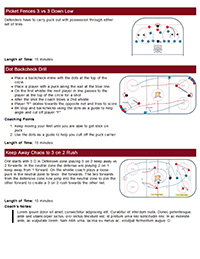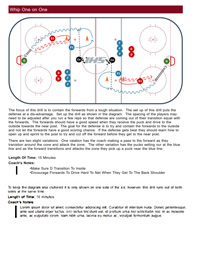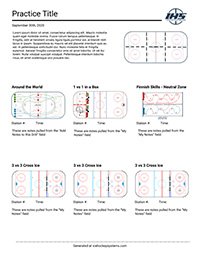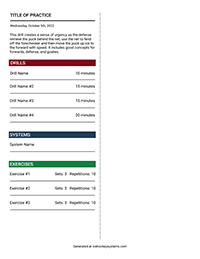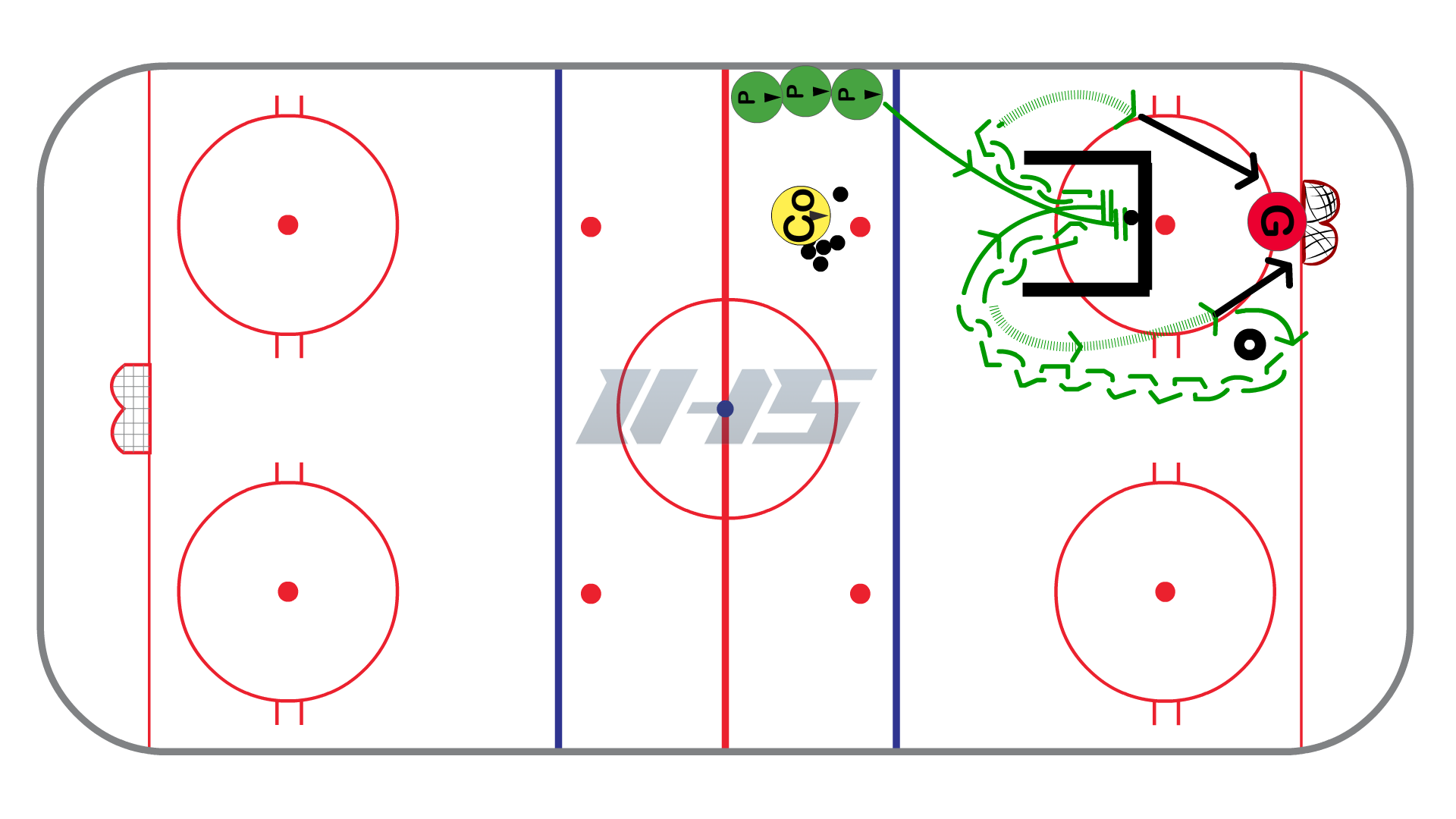
Retrieval Stations
Retrieval Stations

Practice Notes
Please Note: The Practice of the Week is usually designed to be utilized across multiple age levels. With that being said, we highly encourage you to adjust the drills based on your team's age and skill levels. IHS should always be used as a starting point and you can add/remove constraints to fit your team.
Practice Theme: Retrieving the puck along the boards happens countless times throughout the course of the game and it is where many 1 on 1 battles are won or lost. When players collect the puck off of the boards is not usually a highlight-reel play, but if they are able to learn a few simple concepts, they will be able to impact the flow of the game. The purpose of this practice is to get your players comfortable with retrievals in different situations and and to work on 3 retrieval concepts. These concepts will allow players to create space so they have time to make a play and they will become much harder to hit.
Key Coaching Points
- Shoulder Scan - This is concept # 1 because it is most important. Looking over your shoulder will allow you to know if you have time, need to make an evasive move to create time and also allows you to see where your support is.
- Retrieve the Puck at an Angle - This will allow you to keep your speed up while you are going to get the puck so you can make a play. Plus it is much safer than going head-on into the boards.
- Use Deception on Your Retrievals - Implementing skating, stick, body deception into your retrievals when you have pressure will create more time and space for you to make a play.
Practice Layout
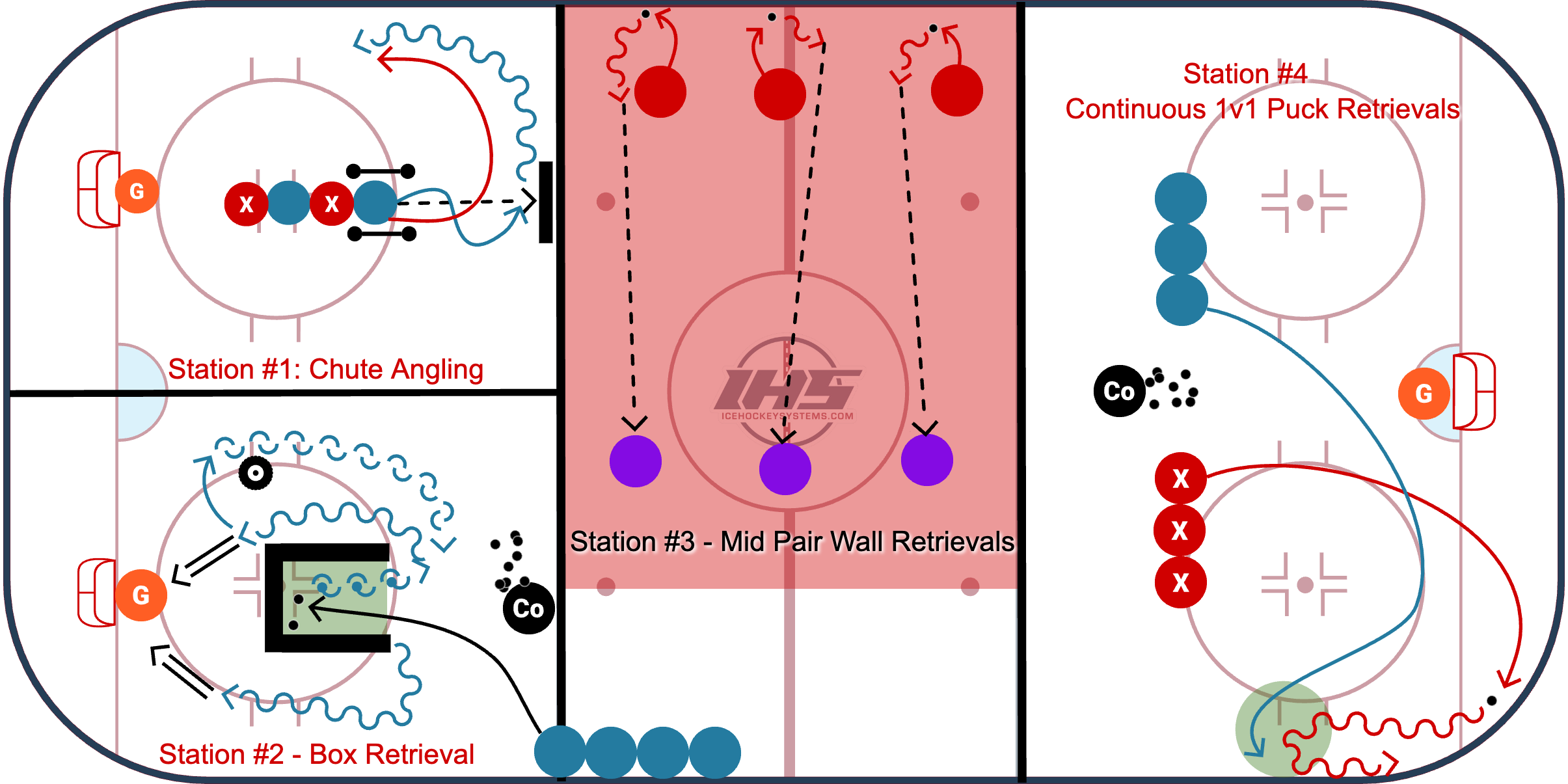
Puck Retrieval Along The Boards
Retrieving the puck along the boards happens countless times throughout the course of the game and it is where many 1 on 1 battles are won or lost. When players collect the puck off of the boards is not usually a highlight-reel play, but if they are able to learn a few simple concepts, they will be able to impact the flow of the game. These concepts will allow players to create space so they have time to make a play. Plus, with an evasive move, they will be much harder to hit!
In the video above, Coach Ben Eaves discusses two major concepts when retrieving a puck:
- Look Over Your Shoulder: This is concept # 1 because it is most important. Looking over your shoulder will allow you to know if you have time, or need to make an evasive move to create time.
- Retrieve The Puck At An Angle: This will allow you to keep your speed up while you are going to get the puck. Plus it is much safer than going head-on into the boards.
The video gives you three options to practice:
- Option 1: If you look over your shoulder and see you have time, continue skating full speed at an angle to pick up the puck and bring it up ice.
- Option 2: If you look over your shoulder and you see you have pressure, skate at an angle but use your upper body to deceive the defending team and quickly turn up ice.
- Option 3: If you look over your shoulder and you see someone right on you, point your feet (which will point your body) one way and quickly move your hips and move your feet in the opposite direction to evade the defender. This is usually the most effective but will take time and good edgework to get comfortable with. Note: When you get comfortable with Option 3, combine the lower body fakes with upper body fakes to really throw off a defender!
Bonus: Watch the Toronto Maple Leafs practice their puck retrievals and forchecking in this fun 1 on 1 battle.
Head Up Scan The Ice Warm-Up
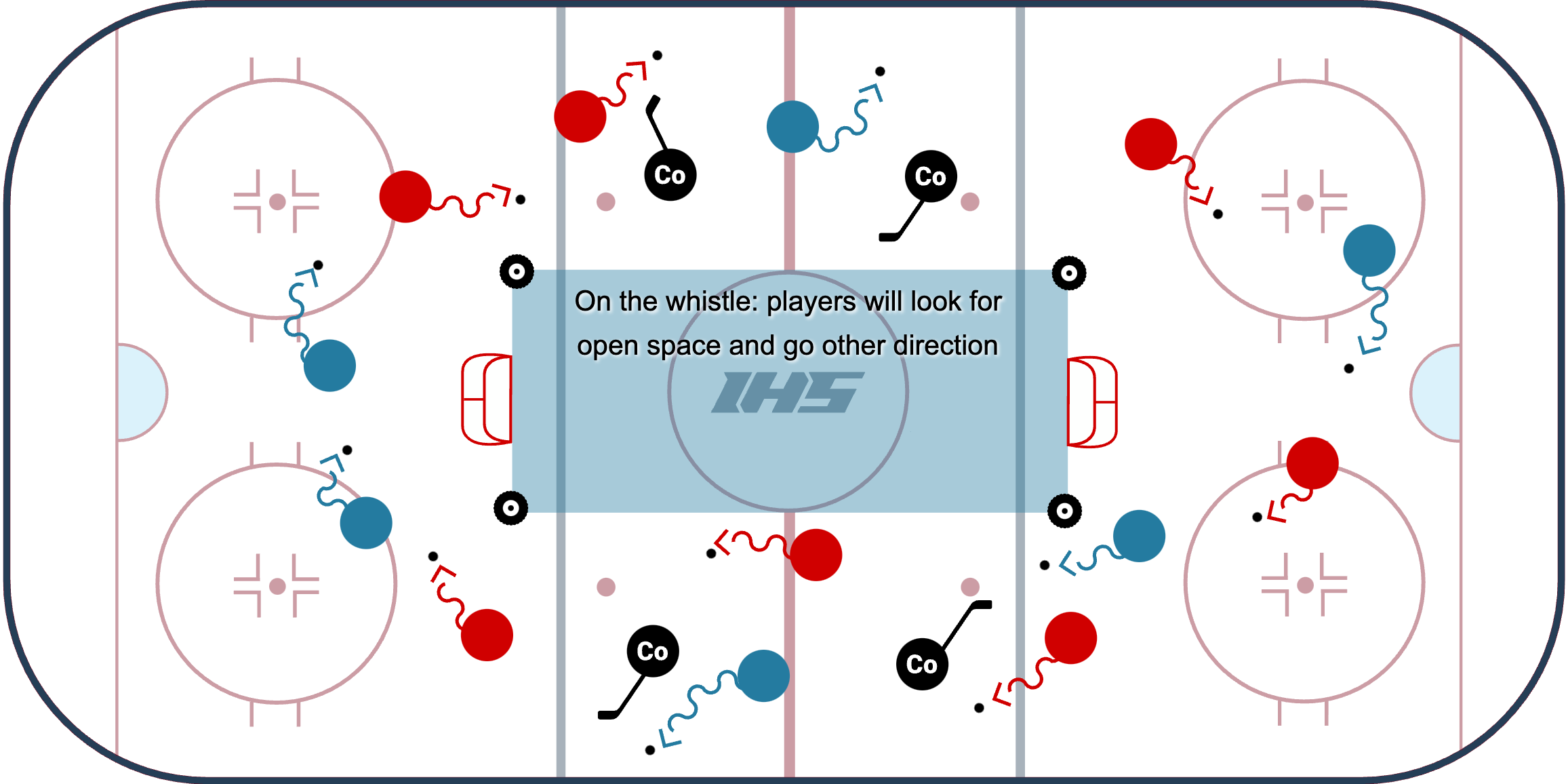
The Head-Up Scan The Ice Warm-Up from Dwayne Blais of the NSDA is a simple yet highly effective warm-up drill that is great for all age levels. The goal of this warm-up activity is to get players in the habit of keeping their head up while they stickhandle so they can look for open ice and evade obstacles.
Setup
- Can be set up to be full-ice (like it is shown in the video) or half-ice.
- On the whistle, all players skate in the same direction.
- On the next whistle, players check their shoulders and turn to go in the opposite direction.
- Coaches can add obstacles (cones, sticks, tires) that players must stickhandle around, and coaches can also be obstacles (like shown in the video).
Coaching Points
- Players should practice keeping their head up!
- Players must shoulder check and look over their shoulder to determine where the open ice is.
- Coaches should encourage players to keep their head up as much as possible during practice. Players can't keep their head up in the game if they do not learn the skill at practice!
Variations
- Can be full ice, half ice, or in zone setup.
- The coach can blow the whistle to change directions every 10 - 20 seconds for younger age groups or every 3 - 5 seconds for higher-skilled groups.
- Can add obstacles and / or defenders that players need to be aware of and stickhandle around.
Chute Angling 1 V 1
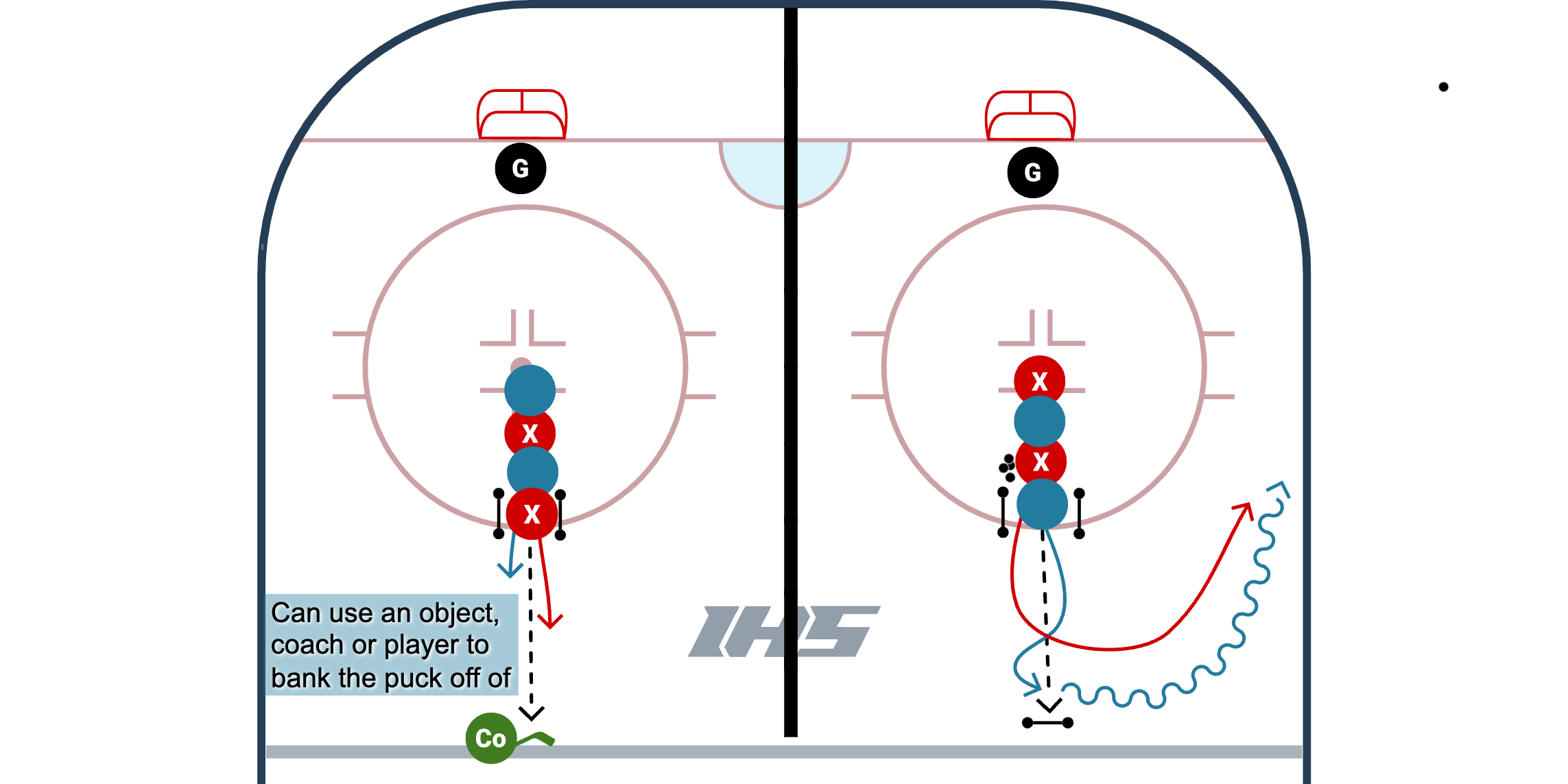
Chute Angling 1 v 1 is a fun drill that allows offensive players to practice deceptive retrievals while a defender works to angle them away from a scoring chance.
Setup
- Set the net up below the face-off circle on the goal line.
- Players line up on top of the face-off circle.
- On the whistle, the second player in line shoots the puck up towards the blue line, either hitting a pad, or a coach's stick.
- The first player in line skates up to the puck and works to deceive the second player in line before they retrieve it.
- When the puck is picked up the 1 v 1 starts and the defender is working to take the puck away and skate past the blueline, while the puck carrier works to score.
Coaching Points
- Defender:
- Gap up and match the offensive skaters speed.
- Pay attention to their body, not their head or skates.
- Keep your stick on the ice and angle them towards the boards, do not let them cut back into the middle of the ice.
- Go stick on puck and finish through their hands to remove the puck from their stick.
- Offensive skater:
- Use deception with your skates, legs, body and head to try to throw off the defender.
- Keep your head up and look for an opportunity to cut back into the middle of the ice.
- If there is no space, keep feet moving and try to protect the puck along the boards and drive to the net.
Variations
- Can set up to be 1/4 ice or 1/2 ice
- Can set up in different areas of the ice
- Can bounce the puck off of a pad, bumper, coach, player, or boards
Three Sided Box Retrieval Station
This is a good skill station that works on forwards to backwards transitions, backwards to forwards transitions, puck retrieval, and shooting. To set up this station you need three barriers, a tire or cone, and one net. Players will line up along the wall and the coach will have the pucks at the neutral zone dot (refer to the diagram). To start the drill:
- the coach throws a puck into the box.
- first player will retrieve it and transition backwards.
- once outside the box the player transitions forwards and takes a shot on net.
- after the shot transition backwards around the tire / cone.
- the coach will throw a second puck back into the box.
- the player will retrieve the puck again.
- transition backwards with the puck.
- transition to forwards on the other side of the box.
- take a second shot on net.
Mid Pair Wall Retrievals

This is a great warm-up drill for defensemen from NewEdge Hockey that can be used all of the time. This setup offers tons of repetitions for common defenseman movements. Deception is a critical, must-have skill for defensemen, and sending false signals takes work to do well. Lots of versions from toes and head left to right take, fan at puck, and so on. Puck on hip, eyes up, and superior passing are skills and habits that defenseman need to make a difference in today's game.
Setup
- Each player has a partner. Player 1 chips the puck to the boards, retrieves it, and passes it to Player 2. Player two then chips the puck and continues the drill.
- Progression # 1: Fake forehand to reverse curl.
- Progression # 2: Head up quick pass.
- Progression # 3: Any variation you want! This setup can allow defenders to reinforce retrieval movements. Use deception and keep your head up!
Coaching Points
- Head up!
- Look over your shoulder as you are skating to the puck (make sure to practice this habit!)
- Practice deception in retrievals with your toes, hips, stick, head & eyes!
Continuous 1 on 1 Puck Retrieval Drill
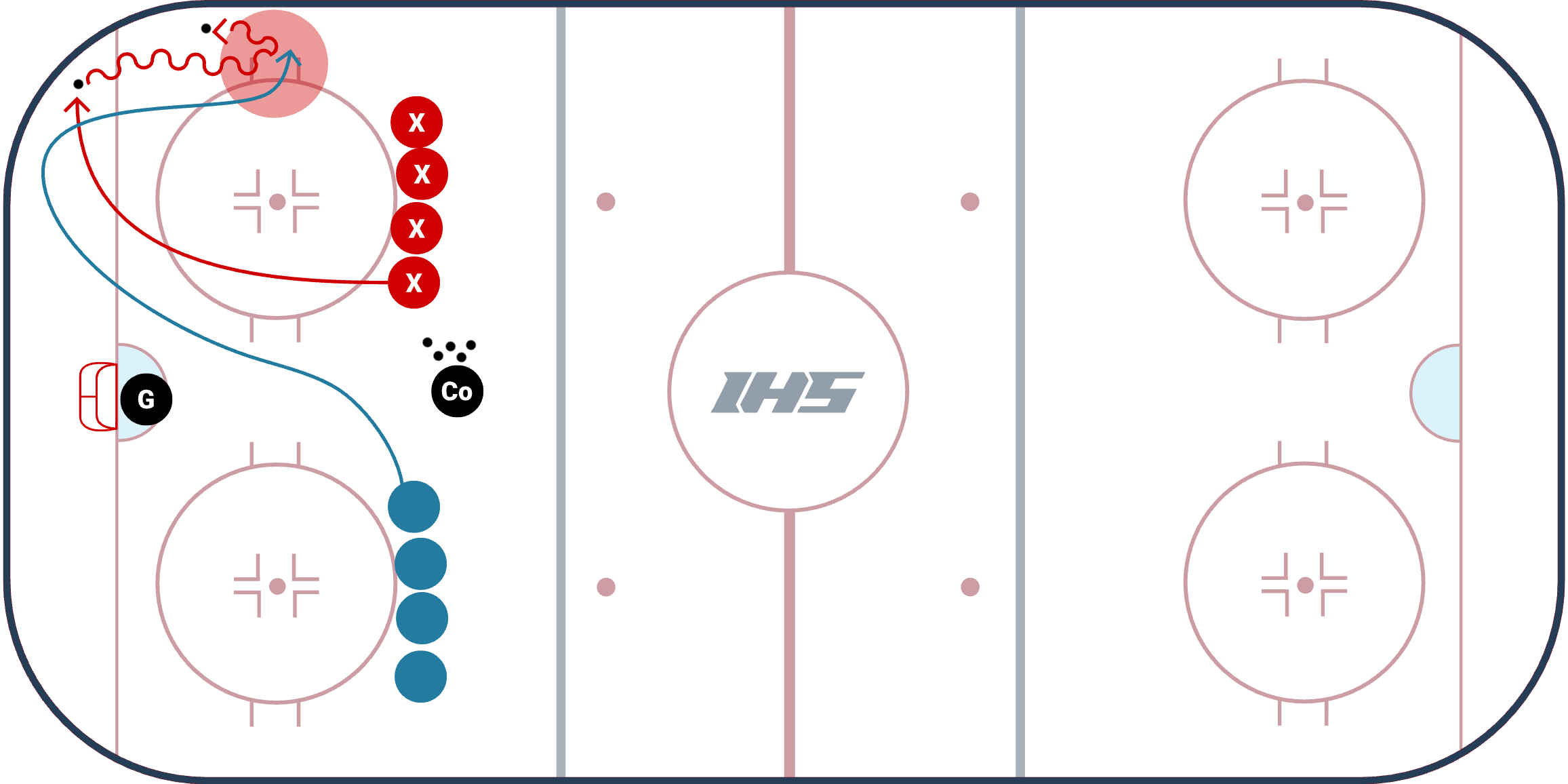
Drill Setup:
- 2 lines of players at tops of the circle. Drill starts with 1 player (X) going to retrieve a puck in the corner. The first O player follows X and gets right next to them so they are now skating up the wall. X (who has puck) now steps into and hits the O player. O is the decoy and allows X to step in and hit them. After the check X turns toward the wall and attacks the net. O then continues and picks up a puck in the opposite corner. As O is going to retrieve their puck a new X player comes in and follows as to be there decoy. Drill is continuous.
Drill Purpose:
- Purpose of the drill is too focus on the puck carrier using checking to nullify the defender and open an opportunity for them to get off the wall and away from the defender.
- In addition it is also meant to reiterate the point that using checking on the offensive side of the puck is the best way to protect ourself as well as the puck.
Variations:
- If the continuous retrieval is too hard for some players, it is suggested that you isolate the skill, and try out the Isolated Bump & Go here.
Redwing 2 V 3 or 2 V 4
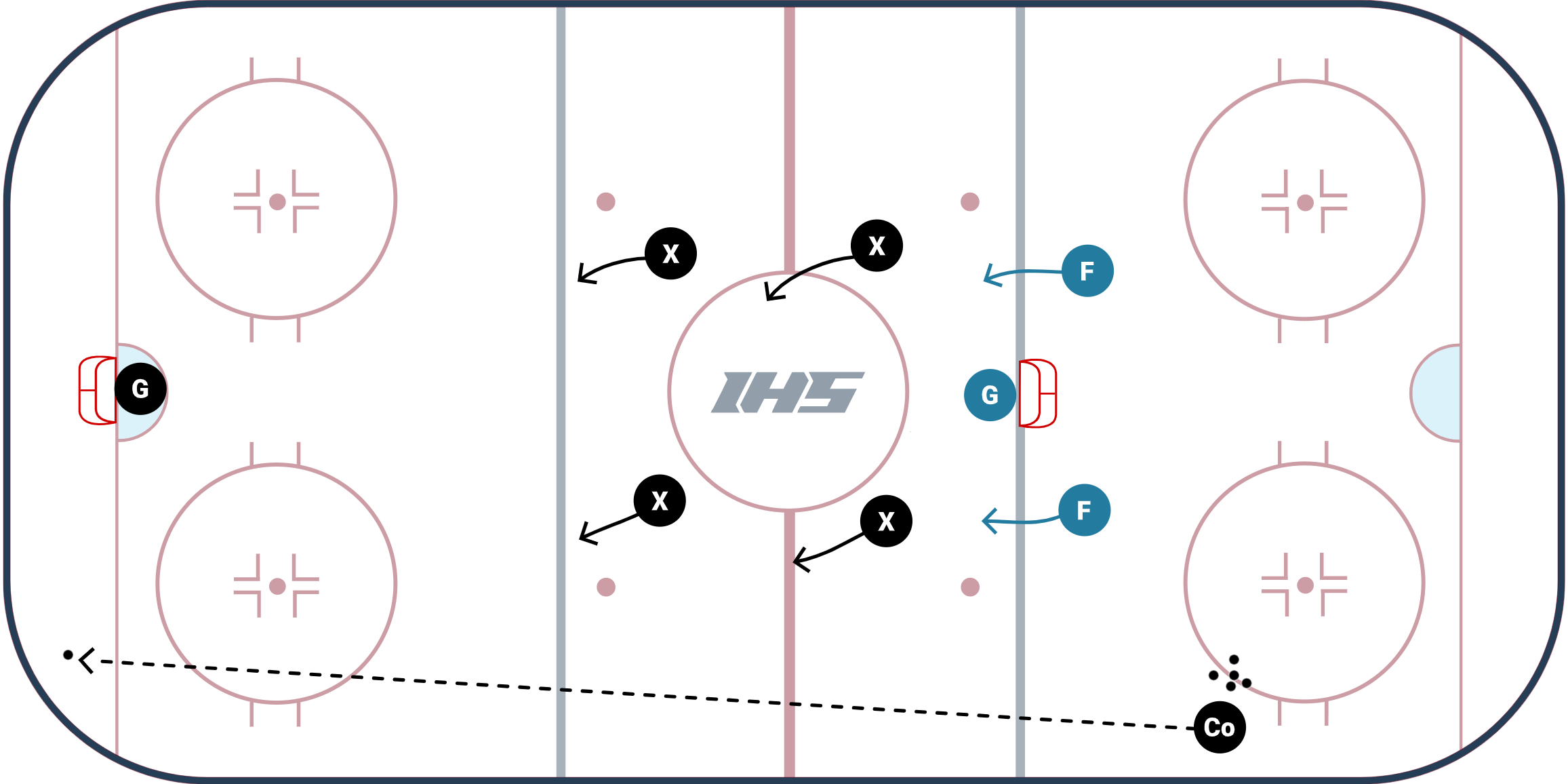
The Redwing 2 V 3 or 2 V 4 from Coach TJ Manastersky is a special teams game that can work on the penalty kill forecheck and power play breakout concepts.
TJ Manastersky shared this game with the IHS Community while he was an Assistant Coach at Union College. TJ is the Current Head Coach at Brock University in St. Catharines, Ontario.
Setup
- Place one net on the far blue line.
- Have 3 or 4 Power Play Players in the neutral zone.
- Have 2 Penalty Kill forecheckers behind the net on the far blue line.
- The drill is started with the coach dumping the puck down to the other end of the ice.
- The all Power Play Players must enter their defensive zone and they attempt to break the puck out and score a goal.
- The Penalty Kill players practice an aggressive Penalty Kill forecheck.
- On the whistle, a new group of players jumps on the ice.
Coaching Points
- Penalty Kill Forecheck should keep speed, attack the puck early.
- The second Penalty Kill forward should try to take away passing lanes in the middle of the ice.
